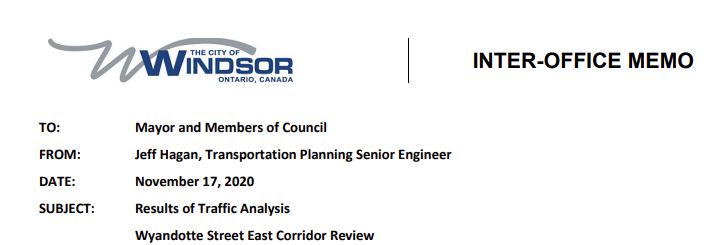
Introduction
Wyandotte Street East has been identified as a candidate for reduction of through lanes to accommodate bicycle lanes along Wyandotte Street. To determine whether this lane reduction is feasible, a corridor review was carried out using Synchro 10 traffic analysis software.
Existing Lane Configurations are shown in Figure 1 (following the body of the memo). Lane configurations with lane reductions are shown in Figure 2.
Traffic Volumes
Existing traffic volumes used for analysis were obtained from recent traffic counts at intersections along the corridor, adjusted to reflect a common 2020 horizon year.
Traffic growth forecasts for future conditions were based on the following assumptions:
-
Diversion from Riverside Drive: as a result of traffic calming measures included in the Riverside Drive Vista Improvement Project, 20% of traffic travelling Riverside Drive between Walker Road and Lauzon Road was assumed to divert to Wyandotte Street.
-
Background Growth: an annual traffic growth rate of 0.5% per year was assumed. This rate is in line with recent historical trends, and reflects a moderate degree of intensification in the area as well as a moderate amount of build-out of the undeveloped lands along Wyandotte Street East to the east of the study area.
-
Mode Share: non-auto (cyclist, transit, pedestrian) mode share was assumed as follows:
-
2020 Existing: 8.3% non-auto mode share (as per the Active Transportation Master Plan – mature neighbourhoods)
-
2040 Ultimate: 22% non-auto mode share (as per the Active Transportation Master Plan – mature neighbourhoods)
-
2030 Interim: 17.4% non-auto mode share
-
Scenarios where an east-west Regional Spine cycling facility is not provided: 8.3% non-auto mode share (i.e. existing status quo)
-
Analysis Results
Analysis was carried out using the Highway Capacity Manual methodology for evaluating urban streets as implemented in the Synchro 10 software package.